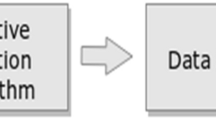Abstract
A standout amongst the most dangers to the cyber security is known as Botnet since it offers a conveyed stage for many undesirable activities. From the network traffic flow, the identification of Botnet is a fundamental test. Artificial Neural Network–Particle Swarm Optimization (ANN–PSO) based botnet discovery is proposed in this paper. In this paper, ISCX dataset is utilized for botnet location. The features are classified as botnet flow and normal flow by giving the features separated from the dataset as a contribution to the grouping. For grouping, we have displayed ANN–PSO which lessens the false classification ratio and time multifaceted nature to 3.3% and 14 s. We contrast our proposed work with other existing work and demonstrate that our work is superior to anything that of alternate works in the simulation results.








Similar content being viewed by others
Data Availability
The already existing algorithms data used to support the findings of this study have not been made available.
References
Karim, A., Salleh, R., Shiraz, M., Shah, S., Awan, I., & Anuar, N. (2014) Botnet detection techniques: review, future trends, and issues. Journal of Zhejiang University Science C, 15 (11), 943–983.
Hoque, N., Bhattacharyya, D., & Kalita, J. (2015). Botnet in DDoS attacks: Trends and challenges. IEEE Communications Surveys & Tutorials, 17 (4), 2242–2270.
Silva, S., Silva, R., Pinto, R., & Salles, R. (2013). Botnets: A survey. Computer Networks, 57(2), 378–403.
Kondo, S., & Sato, N. (2012). Botnet traffic detection techniques by C&C session classification using SVM. Advances in Information and Computer Security, pp. 91–104.
Felix, J., Joseph, C., & Ghorbani, A. (2012). Group behavior metrics for P2P Botnet detection. Information and Communications Security, pp. 93–104.
Bhatia, J., Sehgal, R., & Kumar, S. (2011). Honeynet based Botnet detection using command signatures. Advances in Wireless, Mobile Networks and Applications, pp. 69–78.
Kirubavathi, G., & Anitha, R. (2016). Botnet detection via mining of traffic flow characteristics. Computers & Electrical Engineering, 50, 91–101.
Sedki, A., & Ouazar, D. (2010). Hybrid particle swarm and neural network approach for streamflow forecasting. Mathematical Modelling of Natural Phenomena, 5(7), 132–138.
Das, Gyanesh, Prasant Kumar Pattnaik, & Sasmita Kumari Padhy. (2014). Artificial Neural Network trained by Particle Swarm Optimization for non-linear channel equalization. Expert Systems with Applications, 41(7), 3491–3496.
Leema, N., Nehemiah, H., & Kannan, A. (2016). Neural network classifier optimization using differential evolution with global information and back propagation algorithm for clinical datasets. Applied Soft Computing.
Panimalar, P., & Rameshkumar, K. (2016). Multi variant statistical model for improved Botnet detection in dynamic networks using Particle Swarm Optimization. In IIR 2nd virtual conference on science, Engineering and Technology Applications.
Panimalar,P., & Ramesh Kumar, K. (2015). Time orient multiModel traffic analysis for efficient Botnet detection in internet communication. International Journal of Applied Engineering Research, 10 (21), 42183–42188. ISSN 0973-4562.
Wang, K., Huang, C., Lin, S., & Lin, Y. (2011). A fuzzy pattern-based filtering algorithm for botnet detection. Computer Networks, 55(15), 3275–3286.
Kwon, J., Lee, J., Lee, H., & Perrig, A. (2016). PsyBoG: A scalable botnet detection method for large-scale DNS traffic. Computer Networks, 97, 48–73.
Khattak, S., et al. (2015). BotFlex: A community-driven tool for botnet detection. Journal of Network and Computer Applications, 58, 144–154.
Yahyazadeh, M., & Abadi, M. (2015). "BotGrab: A negative reputation system for botnet detection. Computers & Electrical Engineering, 41, 68–85.
Zhao, D., et al. (2013). Botnet detection based on traffic behavior analysis and flow intervals. Computers & Security, 39, 2–16.
Choi, H., & Lee, H. (2012). Identifying botnets by capturing group activities in DNS traffic. Computer Networks, 56(1), 20–33.
Funding
There is no funding from any Research or Funding Agency.
Author information
Authors and Affiliations
Corresponding author
Ethics declarations
Conflict of interest
The authors declare that we have no conflict of interest.
Additional information
Publisher's Note
Springer Nature remains neutral with regard to jurisdictional claims in published maps and institutional affiliations.
Rights and permissions
About this article
Cite this article
Panimalar, P. Particle Swarm Optimization Algorithm Based Artificial Neural Network for Botnet Detection. Wireless Pers Commun 121, 2655–2666 (2021). https://doi.org/10.1007/s11277-021-08841-1
Accepted:
Published:
Issue Date:
DOI: https://doi.org/10.1007/s11277-021-08841-1




